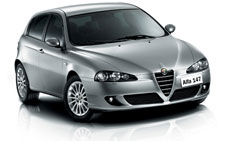Review
But the all-new 147 is aiming much higher up the automotive tree by targeting the Audi A3, BMW 3-series Compact and top-line Volkswagen Golfs.
To encourage these customers to at least consider the marque when their current company car comes up for replacement, the 147 gets an all-new body with more visually arresting styling, more interior space, a superior ride and handling set-up, better performing engines and an intelligently laid out interior that is not only easier to live with but is more pleasing to the eye, taking design cues from the bigger 156 and 166.
While the bonnet bulge, scalloped flanks and teardrop tail-lights are familiar Alfa Romeo features, the new 147 takes the V-shaped signature grille to extremes and stretches it below the bumper line to the front sill.
It gives the 147 a much younger image - but whether it's pretty is more debatable. What undoubtedly works, though, are the reshaped headlights and wheel-at-each-corner stance that gives it a very compact, yet purposeful presence on the road. Like the 156, the styling is the same on the three-door and five-door variants thanks to the cleverly disguised C-pillar-mounted door handles.
The improvements in the quality of the plastics, switchgear layout and seating position apparent on the 156 and 166 have been carried across to the 147 but with a younger spin: the aluminium-rimmed and cowled speedo and rev counter dominate the instrument panel and on top-spec versions the Connect telephone/ audio/navigation display from the 166 tops the centre console. Thanks to a height-adjustable driver's seat and height and reach adjustable steering wheel, the driving position is easily tailored to fit all sizes.
It's all change under the bonnet, too. There are four engine variants: a 1.6-litre 16v Twin Spark unit delivering 105bhp or 120bhp, a 2.0-litre Twin Spark with 150bhp and a 1.9-litre JTD common rail turbodiesel with 110bhp. All engines will be available with a five-speed manual gearbox but the 2.0-litre can also be ordered with the semi-automatic Selespeed transmission.
There will be a phased launch in the UK: from February just two variants will be available but in three-door guise only: the 120bhp 1.6 (we won't get the less-powerful 105bhp engine) and the 2.0-litre with the Selespeed 'box. By the end of May, five-door versions of each petrol engine will added plus the 1.9-litre JTD diesel in three- and five-door guise. The 156 has been further used as the blueprint for the 147 with the adoption of the double wishbone front suspension, greater torsional rigidity for sportier handling and increased front and rear track for better stability.
What's most noticable over the first few miles, though, compared with the outgoing 145/146 is the fantastic steering. Quick and communicative, it makes the driver feel involved and in control of the whole driving experience.
The bulk of 147 customers will go for the 1.6-litre and while this is a gutsy performer the enjoyment is spoilt by the oddly-spaced gear ratios. Even during our brief drive on the twisty roads around Monaco, we consistently found the space between second and third gear simply too big: with just 108lb-ft of torque available at a highish 4,200rpm, the mismatch between the engine's willingness to rev and the poor top-end response quickly becomes tiresome and any relief gained from changing to third is removed by the sharp drop-off in power. Smooth progress isn't helped by the vague and long-throw gearchange either. The ride, too, is surprisingly bumpy and hard. Top speed is 121mph with 0 - 62mph taking 10.6secs. Average fuel consumption is 34.4mpg. Carbon dioxide emissions for the 1.6 in 120bhp form are 194g/km, compared with 181g/km for the Ford Focus 1.8, 190g/km for the Volks- wagen Golf 2.0 GTI and 202g/km for the Audi A3 1.8. The 2.0-litre, though, is a far better bet. With a less raucous exhaust note, more compliant ride quality and the more powerful engine makes for a faster, yet more relaxing drive.
Matched to the 156's Selespeed transmission which has been refined for smoother gear changes - this time with up/down paddles mounted behind the steering wheel unlike the 156's push-button system - it not only works well but is great fun to use; downchanging induces a wonderful heel-and-toe blip of the throttle without the need to master the technique. Top speed is 129mph and 0 - 62mph arrives in a quick 8.3secs. Average fuel economy for the 2.0-litre is 32mpg and CO2 emissions are 211g/km compared with the Volkswagen Golf 1.8T at 190g/km.
When the JTD arrives it will deliver 110bhp and 202lb-ft of torque (Golf TDI PD manages 210lb-ft), sprints from 0 - 62mph in 10.5secs and returns 49.5mpg. CO2 emissions are 152g/km. against the Golf 1.9 TDI PD's 146g/km.
It's more spacious inside with a generous amount of headroom in the rear although legroom is quite tight. The rear bench seat is also only really big enough for two adults.
Although final trim specifications and pricing haven't yet been announced, standard equipment across the range is likely to include six airbags including window bags, all-round disc brakes, ABS with electronic brake force distribution (EBD), manual air conditioning, remote central locking, 15in alloy wheels plus electric front windows and door mirrors.
There's no doubt sales of the new 147 will be higher than the outgoing 145 and 146. It has much improved build quality, drivability, performance and looks but the ride quality and rear seat space disappoint, making this less of a convincing all-rounder than the 156.
The limited availability from February is also surprising: Alfa reckons 10% of 156 2.0 buyers choose the Selespeed option - but then 90% don't. The only way Alfa can seriously challenge the champions of the C-sector is by a massive splash into the market and as much choice as possible.















